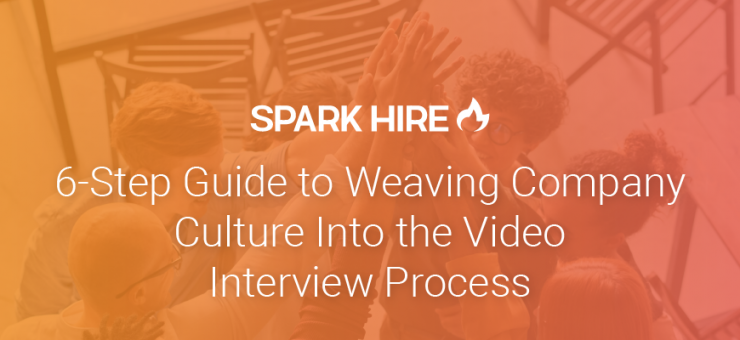Company culture has shifted since the migration to hybrid and remote workforces. Even those organizations that have returned to offices since the 2020 pandemic may have updated workflows or built new teams.
Most employers that started using video interviews during the pandemic plan to keep using them. This means hiring decision-makers will rely on the accuracy of early screenings through one-way video interviews or live video interviews over traditional phone screens and in-person introductions.
Of course, it is crucial that your hiring team uses the right video interview tools and interview processes to assess for culture fit. However, to grow and be successful, your hiring team must understand what makes your work culture unique and the essential qualifications that ensure candidates fit. To make it simple, we’ve broken down the process into six steps:
Identify significant criteria for culture fit
Company culture is not stagnant. Your work culture evolves as your workforce grows and new talent leaves a footprint on the team. Factors such as changing work models or the innovation of your services and products can impact the talent you attract and your workplace culture.
If your interview process is outdated, your quality of hire will suffer, and so will your team. Therefore, you must keep a pulse on what it means to fit your company’s culture.
First and foremost, your hiring team should screen for talent that aligns with your company’s values and mission. It doesn’t matter if a new hire cares for donuts at Monday morning meetings as much as if they feel strongly about your company’s position on environmental sustainability or showing support for social initiatives. Identify critical elements of your values and mission, and weave those factors through the fibers of your talent acquisition strategy.
Look at how company values shine in your work culture. Perhaps team members volunteer together at a local shelter or sponsor a community in need of clean drinking water. Or maybe team leaders take time to build relationships with employees by hosting weekly one-on-one lunches at family-owned restaurants nearby.
When building out your one-way and video interview questions, key indicators of culture fit need to be apparent. Candidates should clearly understand the company culture early in the interview process.
Determine differences between in-person/remote cultures
The core of your company culture should be consistent across departments. Yet, you may notice that teams have quirks that keep them engaged in their work. This can stem from personalities being drawn to different roles. For example, your marketing department could have more elaborately decorated workspaces than the finance department. But when it comes to meetings and watercooler talk, the similarities that nurture the connections your team build are apparent.
You can say the same for your in-office team versus your remote employees. Whether you offer flexible/hybrid roles or your entire workforce works from home, take note of differences in your work culture. For example, your remote work team may like to chat throughout the day on Slack and use more emojis than co-workers who can fill the office silence with jokes and small talk. It’s your job to ensure everyone has an appropriate way to communicate and connect, so they feel engaged with their work and team.
Your hiring team also needs to assess talent to fit into these work environments. For example, suppose your remote team prefers to keep everyone notified when they are at their desks, how long they are stepping away, or interject videos, music, or memes throughout the day. In that case, new hires who prefer to work alone may feel overwhelmed. Similarly, someone who likes a workplace that’s hopping with energy could feel out of place if the office vibe is introverted and lowkey.
Determine what makes your in-office and remote cultures successful at nurturing teams to work together and independently. Then, identify criteria to screen new hires to feel productive and at ease in their new roles.
Develop structured interview questions for culture fit
Behavioral questions that screen for competencies and personal qualities you can’t train for are a great way to evaluate talent for culture fit. Opened-ended questions work perfectly for one-way video interviews in the early screening stages of your hiring process. Consider different work scenarios and examples from your team to make the questions relevant and responses easy to rate accurately.
As much as we believe we can predict how we’d react or come to the best decision when given hypothetical scenarios, there are variables no one can account for. Sometimes, a real-life solution isn’t wrong; it’s just not the behavioral response that fits with the team culture. Ask candidates structured questions and evaluate responses through a simple scoring system by which decision-makers can collaborate. This process helps hiring teams see which candidates fit objectively.
Structured interviews also reduce bias meaning your team can grow exponentially in culture fit and culture add. Once you clearly define your culture, anchor specific values and qualities to job-related competencies and quantifiable contributions. Measuring all candidates against these criteria ensures you don’t miss out on the best-fitting candidates.
Top candidates who advance to live video interviews have a unique opportunity to expand on their experiences, but all questions should follow the structure mapped out for everyone in the hiring process. Keeping your structured interview process consistent allows decision-makers to provide accurate feedback throughout the entire interview process.
Set clear evaluation criteria
Asking candidates the same questions is futile if you are not scoring talent on structured evaluation criteria. Your hiring team needs to understand the evaluation process, why specific feedback is necessary, and how their contributions help the decision-making process.
Some companies still rely on traditional interview methods. Passing candidates through interview after interview, checking boxes, and comparing notes are antiquated processes that create a more significant margin for error. Fortunately, video interviews reduce your hiring time by eliminating redundant interviews and allowing decision-makers to collaborate more effectively.
One-way video interviews are submitted by candidates and can be reviewed by anyone on your team at their convenience. The evaluation criteria for this stage funnel highly-qualified candidates onto in-person and live video interviews. Screening for culture fit is crucial in this step. Therefore, your company culture qualifications that are non-negotiable should be highly-prioritized in your one-way video interview questions.
One of the best benefits of one-way video interviews is that they can be stored in your candidate database to revisit for future open roles. If you find candidates who are great culture fits but don’t meet your requirements for hard and soft skills, you can add them to your talent library and keep tabs on their development through networking.
Live video interviews enable multiple interviewers to meet with a candidate simultaneously or can be automatically recorded and shared with decision-makers who can’t attend. Through collaborative evaluation features like ratings and comments, everyone can access quick feedback from key stakeholders in the hiring process. The rejection reason is available for everyone to review if a candidate is not a good culture fit.
Communicate your culture through all messaging
Culture fit is an essential part of feeling a sense belonging to a new company. Video technology has come a long way in helping brands promote workplace culture.
You can use social media to share videos of everything from important company events to day-to-day office shenanigans. Real-life examples of your culture help attract talent that feels as though they would thrive in your work environment and with your team.
Posting introductions and testimonials of leaders and team members breaks down social barriers before candidates apply. And sending out custom video messages when connecting with candidates adds a personal touch to recruiter communication.
Candidates get a fully-branded experience when you use a video interview platform to connect with talent. Dedicated video interview technology allows you to weave your company culture and branding through video messaging and video interviews. As a result, candidates’ experiences with your brand are positive, consistent, and memorable.
Make your culture inseparable from your branding
You can also use branded videos to demonstrate how your culture is inseparable from your brand identity. Share unique facets of your work culture that resonate with candidates’ expectations.
For example, does your company prioritize work-life balance and offer family-focused benefits? Encourage employees to post openly about attending little league games around their flexible work schedule – and how co-workers or managers show up to support them.
Let candidates see that leaders set a positive example for employees by using their PTO and going off the grid – trusting their team to keep everything moving forward. This helps attract talent to your open roles and reinforces the importance of well-being and boundaries in your culture. Leadership is reminded to lead by example, employee engagement stays high, and burnout is less likely to occur.
Share memes, inspirational quotes, and tips team members contribute or appreciate in the workplace. And engage with social followers through the authentic voice of your company culture and brand. That way, employees feel natural engaging through company social channels, and candidates know what to expect coming into the hiring process.
Additionally, these references are a great way to identify candidates who have researched your brand and feel connected with your culture in the interview process. Being transparent about your work culture assures applicants are invested from their first exposure to your brand. And attracting high-quality and committed candidates streamlines your video screening process and improves your hiring outcomes.










